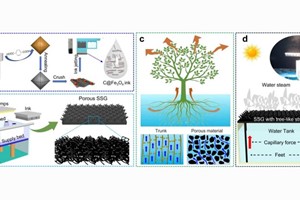Researchers have developed bioinspired 3D-printed solar steam generators (SSGs) designed for desalination, with potential applications in solar energy conversion and water purification. Confronted with the looming global freshwater scarcity, a team from Singapore has advanced the capabilities of SSGs, a promising solution for seawater desalination. Traditional desalination methods are often costly and energy-intensive.
This innovative approach harnesses solar energy to mimic the natural water cycle, evaporating and isolating water. However, the effectiveness of this technology is often hampered by the need for complex topologies to increase surface area and enhance water evaporation efficiency.
To address this challenge, the researchers drew inspiration from trees and leveraged 3D printing technology. Their findings, published in Applied Physics Reviews, showcase a cutting-edge technique for producing efficient SSGs and introduce a novel method for printing functional nanocomposites using multi-jet fusion (MJF).
"We created SSGs with exceptional photothermal performance and self-cleaning properties," stated Kun Zhou, a professor of mechanical engineering at Nanyang Technological University. "Using a treelike porous structure significantly enhances water evaporation rates and ensures continuous operation by preventing salt accumulation — its performance remains relatively stable even after prolonged testing."
The underlying physics of their approach involves converting light to thermal energy, where the SSGs absorb solar energy, convert it to heat, and subsequently evaporate the water or seawater. The porous structure of the SSGs aids in self-cleaning by removing accumulated salt, thus ensuring sustained desalination performance.
"By using an effective photothermal fusing agent, MJF printing technology can rapidly create parts with intricate designs," Zhou explained. "To improve the photothermal conversion efficiency of fusing agents and printed parts, we developed a novel type of fusing agent derived from metal-organic frameworks."
Inspired by plant transpiration, their SSGs are composed of miniature tree-shaped microstructures that form an efficient, heat-distributing forest. "Our bioinspired design increases the surface area of the SSG," Zhou noted. "Using a treelike design increases the surface area of the SSG, which enhances the water transport and boosts evaporation efficiency."
One notable outcome was the high rate of water evaporation observed in both simulated environments and field trials. The desalinated water consistently met drinking water standards, even after prolonged testing. "This demonstrates the practicality and efficiency of our approach," Zhou said. "And it can be quickly and easily mass-produced via MJF commercial printers."
The team's work holds significant promise for addressing freshwater scarcity. "Our SSGs can be used in regions with limited access to freshwater to provide a sustainable and efficient desalination solution," said Zhou. "Beyond desalination, it can be adapted for other applications that require efficient solar energy conversion and water purification."













